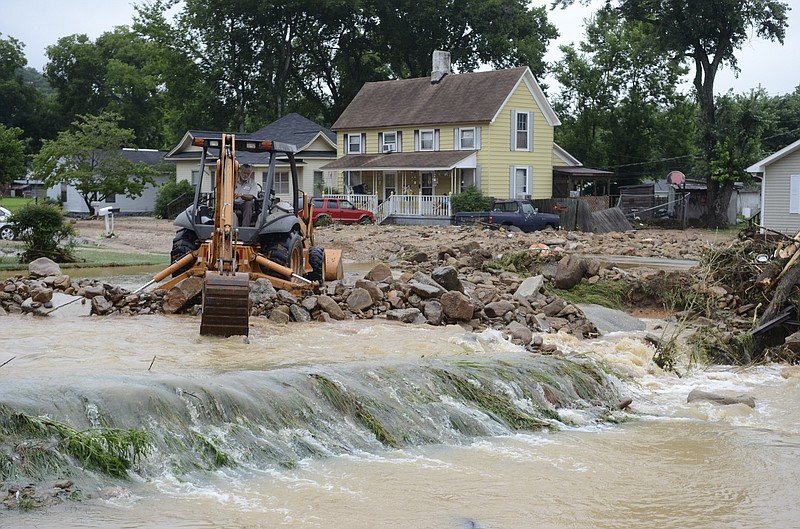SOUTH PITTSBURG, Tenn. – It happened again.
On Christmas morning, after days of moderate rainfall, a 20-minute torrential downpour caused another flash flood in downtown South Pittsburg and the Richard City area that damaged property and took the life of resident Alice Reynolds.
At the January meeting of the South Pittsburg City Commission, officials discussed what could be done to prevent yet another disaster.
"This is something that's happened again in less than three years," Marion County Mayor David Jackson said. "Another 30 or 45 minutes of rain, and it would've probably been worse than what we had back in 2013."
Jackson and Southeast Tennessee Development District Executive Director Beth Jones decided to put together a task force to address the issue and look for a solution.
The task force will include the county mayor's office, South Pittsburg city leaders, Marion Emergency Management Director Steve Lamb, the Tennessee Emergency Management Agency, the Tennessee Department of Transportation, the Tennessee Department of Environment and Conservation and the National Weather Service, among others entities.
Jackson said the first step is to hire some engineers to study the town's flooding problems and give the task force ideas about what to do.
Some engineers have suggested a "retention system" be built above the town to hold the water back so that it could drain more slowly, Jones said.
"They don't know," she said. "That's why it's got to be studied. It's got to be something that, once you can afford to put it in, can you afford to maintain it? That's all at the taxpayers' expense."
Jackson cautioned that a potential solution is "not going to be something that happens overnight" and is "not going to be cheap."
What the town can't afford, he said, is to lose its residents and its businesses.
"If I could fix it tonight, I'd wave my wand and we'd have it solved," Jackson said. "We're going to work on it. We're going to work on it hard until we figure out what can be done."
Third Street is typically one of the hardest-hit areas by flash floods because the main stormwater drain leading to the Tennessee River lies just beneath the road.
Roy and Linda Ferrell have lived on that street for 46 years, and both said they hope the task force can come up with a solution.
Linda Ferrell, who fell and broke her foot on debris left behind by the latest flood, said the Christmas and 2013 floods were only part of the inundations they've experienced over the years.
"We can't leave," she said. "We've been there too long. I don't know how to fix it. This is all good talk, but let's do something about it."
Her husband agreed and said he's heard a lot of discussion but not seen much action.
"People have been studying, talking, listening, and discussing it for over a hundred years," Roy Ferrell said. "Are we just going to continue that same rhetoric for another 50 or 60 years? That's what I'm concerned about."
One possible solution could be setting up a stormwater utility, similar to the one in Chattanooga.
Residents of Chattanooga are charged a stormwater utility fee of about $115 per year for construction and maintenance of flood control projects.
Mark Heinzer, Chattanooga's engineering manager for drainage and flood control, said making the problem a legal matter won't fix it. Instead, officials should be proactive and "get ahead of this."
Heinzer said the task force is "on the right track" with its approach and volunteered to be one of its members.
"Just clearing the land of trees doubles the stormwater coming out," he said. "You don't even have to build anything. You've just doubled the rate and the volume in which it's coming out."
South Pittsburg has tried to address the problem on "a number of different occasions," Jones said, but those efforts have been "Band-Aids."
Not having a state-approved flood mitigation plan in Marion had been an obstacle to government grant funding, but she said that's no longer an issue after the county's plan was accepted recently.
Jones said the town and the task force would have to proceed cautiously so as to not "engineer itself" into a problem they are trying to solve.
For example, she said the U.S. Highway 72 bypass just outside of town was built, in part, as a levee to protect the town from flooding by the nearby Tennessee River.
"For every action, there's a reaction," Jones said. "Now, the bypass somewhat acts as a dam to the stormwater that's coming off the mountaintops."
The task force's meetings will be advertised in the local newspaper and on the town's website.
Jones said those meetings would be open to the public, and she encouraged residents to attend and provide input.
"Anytime there's more development, clear-cutting, or rock harvesting, water runs downhill," she said. "If you're at the bottom end of it, it's going to come down on you. We've got to work together with all of these communities to take really hard looks at impacts that are going on."
Ryan Lewis is based in Marion County. Contact him at ryanlewis34@gmail.com.
